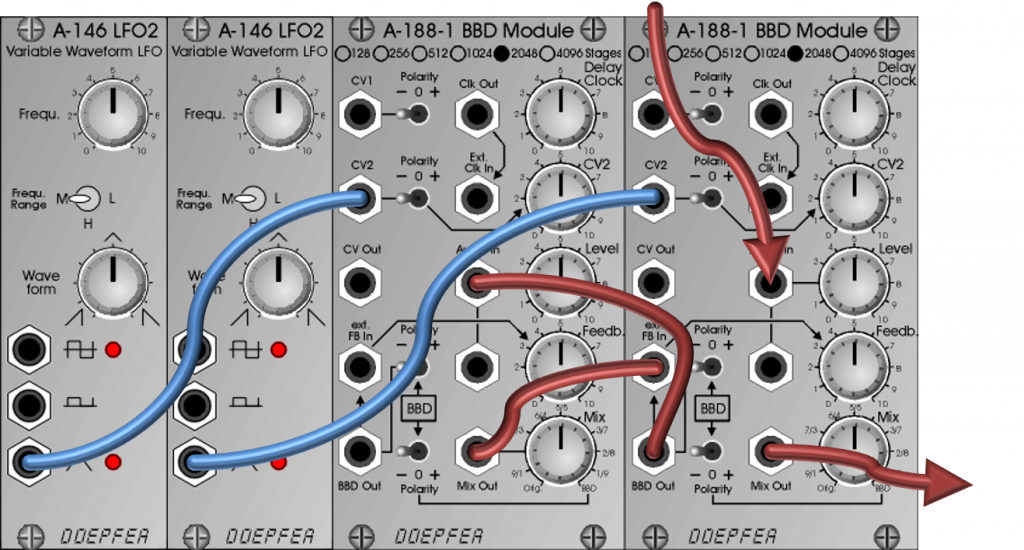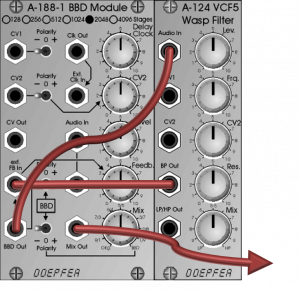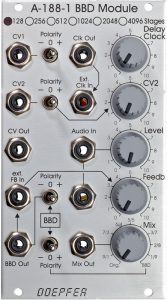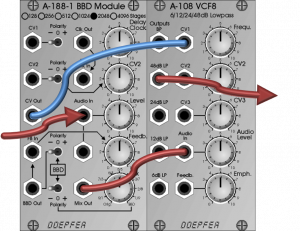The A-188-1A module (512 steps) is a discontinued model and will unfortunately no longer be produced in the future.
Status: January 2023
BBDs – “Bucket Brigade Devices” are based on (analogue) storage components for voltages that are clocked through quickly by an internal oscillator. The voltage present at the input of the module is picked up by the first “bucket” and then passed on to the next bucket in time with the internal oscillator, until it is finally released by the last bucket at the output of the module. In this way, an AC voltage present at the input (an oscillation, a tone, a noise) is “sampled” so to speak and output again with a delay. The lower the clock frequency of the BBD oscillator, or the more memory “buckets” are traversed, the longer the delay.
By mixing the delayed signal with the original signal, repeatedly feeding the output signal into the BBD or modulating the internal oscillator, a wide range of sounds such as echoes, chorus or flanger can be created. BBDs can also be used as oscillators thanks to the Karplus Strong Synthesis!
The clock frequency of BBDs, however, cannot be varied completely arbitrarily. Upwards it ends at about 200-250 kHz (by the way, we are able to hear sounds up to about 15 kHz), downwards, at the latest at 10-15 kHz, the clock frequency itself can be heard as – mostly unwanted – background noise and then usually has to be filtered out, which also reduces the overtones of the sound. In addition, the sound quality drops significantly at low clock frequencies due to artefacts such as loss of voltage on the transport route through the bucket chain.
That’s why Doepfer offers several BBD models with bucket chains of different lengths: from 128 steps for extremely short delays (flangers, chorus from 1/3 millisecond!) to 4096 steps for echoes up to around 200 ms.
User interface
Inputs:
EN-CTRL-A188-1-INOutputs:
EN-CTRL-A188-1-OUTSwitches:
EN-CTRL-A188-1-SW1Important: The labels (+) and (-) of the two switches for the polarity in the feedback path and for the polarity of the BBD signal before mixing with the original signal are swapped.
Knobs:
EN-CTRL-A188-1-SW2Filtering noise from the HF VCO
In order to filter the noise at a low clock frequency of the HF-VCO, a filter with a steep edge is useful, which leaves as much of the “useful signal” as possible. An ideal “partner module” (and otherwise a very good sounding filter) is the A-108 48dB filter, which can be quite precisely matched to the BBD frequency, even if this is changed by modulation.
And this is how it works: Connect the “CV Out” of the BBD to the “CV1” input of the A-108 and set the cutoff-frequency manually with a low delay clock so that you just can’t hear the HF-VCO anymore.
Flanger, chorus, echo
The usual area of application for BBDs are modulated delays such as flangers and chorus, as well as echo effects with longer delay times. The modules with 128 to 512 steps are particularly suitable for flangers or chorus. With the other BBD modules, short echo effects are also possible – although not in the sense of today’s digital delays, which can delay several seconds. Even with the A-188-1D and its 4096 steps, you only get 200 ms with a reasonably tolerable audio quality.
Looping other modules into the feedback path
You can get unusual chorus/flanger sounds by adding a filter or another BBD etc. in the feedback path.

Oscillating delays: The A-188-1 BBD modules as sound generators
A BBD (Bucket Brigade Device) takes an input signal and passes it through several steps like a bucket filled with water until the signal is output again at the last step. The passing of the bucket is clocked at a very high frequency and each of these steps takes a certain amount of time, so BBDs are mainly used as delays.
How can you create sounds with something like that? Very similar to using a filter, either via self-oscillation at high feedback (i.e. the BBD’s output is fed back into the input until it squeaks), or via short impulses with feedback shortly before self-oscillation (as in “Filter Ringing”). The second case is very interesting in terms of sound, with a filter in the feedback path you get the so-called Karplus-Strong-Synthesis, which can produce very peculiar “natural” sounds (roughly like plucked strings).
Doepfer offers various BBDs: The A-188-1 is equipped with a different number of bucket chain steps (from 128 to 4096) and correspondingly different delay times. For use as a sound source and for flanger effects, the shorter step lengths (up to 1024 steps) are usually more interesting, for “echo” effects the longer ones.
A BBD in near self-oscillation oscillates at a frequency equal to the reciprocal of its delay time. Everything clear? A delay that works with a delay of 1 / 1000 second can then reproduce a crackling 1000 times per second as an echo that becomes increasingly dull and quiet. From a thousand clicks per second we then get a vibration of 1000 Hz. That’s the thing about the reciprocal.
This can now be controlled via one of the control inputs “CV1” or “CV2” (unattenuated) with a characteristic of – roughly approximated – 1 V / octave, so we can play the oscillating delay tonally via keyboard or sequencer!
Which pitches can be reached?
The different BBD modules also have different achievable pitches. A very short delay produces a high pitched tone, and a long delay produces a low pitched tone.
A value of 20 kHz was set as the minimum internal BBD frequency in the overview table. Otherwise you would have to filter out noise that would be caused by the BBD clock itself. Below 20 kHz, this clock oscillator is already in the audible range.
| Model: | Delay times: | Achievable pitch: |
|---|---|---|
| A-188-1X (128 stages) | 0,3 ms – 3,2 ms | 3.125 Hz – 312,6 Hz |
| A-188-1Y (256 stages) | 0,6 ms – 6,4 ms | 1.562,5 Hz – 156,3 Hz |
| A-188-1A (512 stages) | 1,3 ms – 12,8 ms | 781,3 Hz – 78,1 Hz |
| A-188-1B (1024 stages) | 2,6 ms – 25,6 ms | 390,6 Hz – 39,1 Hz |
| A-188-1C (2048 stages) | 10,2 ms – 51,2 ms | 97,7 Hz – 19,5 Hz |
| A-188-1D (4096 stages) | 20,5 ms – 102,4 ms | 48,8 Hz – 9,8 Hz |
An attainable pitch of 9.8 Hz (virtually anything below about 25 to 30 Hz) is of course illusory – this is no longer perceived as a “tone” but as a click with an echo of 1/10 second delay.
But something like that can also be used as a noise in the right context.
Filter in the feedback path

A filter can be looped into the feedback path of the BBD: This allows you to intervene very specifically in the sound – in addition to the “natural” sound change of the delays through the BBD. Experimentation makes sense here, nice results can be achieved with a bandpass filter, for example.
Sound examples
Noise from an A-117 is first fed into an A-132-3 VCA controlled by an A-142-1 VC Decay with very short envelopes. These short noise pulses are fed into the input of an A-188-1X BBD. An A-155 sequencer triggers the envelopes and controls the frequency of the BBD. In addition, an A-185-2 is used to switch the BBD down by 1 octave every 30 seconds (this doesn’t work perfectly like a VCO, of course).
An A-108 in bandpass mode is integrated into the feedback loop (manually controlled, emphasis set to 0). The BBD’s output signal runs into a second A-108 filter in 48 dB LP mode. The cutoff-frequency is controlled by the BBD Frequency CV Out. This filter is used to eliminate interference noise from the BBD internal HF oscillator.
Technical specifications
| Width | 14 HP |
| Depth | 60 mm |
| Power requirements | 80 mA (+12V) / -50 mA (-12V) |

